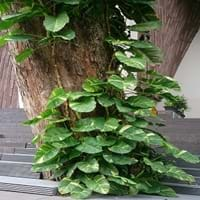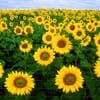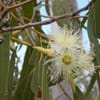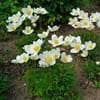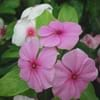Life Span
Annual
Perennial
Type
Flowering Plants
Vines
Origin
North America
Australia, China, India, Japan
Types
Helianthus annuus, Heliantheae,
Marble Queen, species itself, Neon, all-green
Habitat
Dry areas, Open areas, Prairies
Humid climates, Tropical regions
USDA Hardiness Zone
3-10
10-11
Sunset Zone
A1, A2, A3, H1, H2, 1a, 1b, 2a, 2b, 3a, 3b, 4, 5, 6, 7, 8, 9, 10, 11, 12, 13, 14, 15, 16, 17, 18, 19, 20, 21, 22, 23, 24
Not available
Habit
Upright/Erect
Prostrate/Trailing
Minimum Height
Not Available
Flower Color
Brown, Yellow
White
Flower Color Modifier
Bicolor
Not Applicable
Fruit Color
Black, Chocolate, Ivory
Yellow Brown
Leaf Color in Spring
Dark Green, Green
Yellow
Leaf Color in Summer
Green
Light Green
Leaf Color in Fall
Green
Light Green
Leaf Color in Winter
Not Available
Light Green
Plant Season
Summer
All year
Sunlight
Bright direct sunlight
Partial shade
Growth Rate
Very Fast
Fast
Type of Soil
Dry, Light, Well drained
Loamy
The pH of Soil
Acidic, Alkaline
Neutral
Soil Drainage
Well drained
Light
Bloom Time
Early Fall, Early Summer, Fall, Late Spring, Late Summer, Summer
Mid Summer
Tolerances
Not Available
Dry soil, Shade areas, Sun
Where to Plant?
Container, Ground, Pot
Ground, Pot
How to Plant?
Seedlings
Seedlings, Stem Planting
Plant Maintenance
Medium
Medium
Watering Requirements
Keep the ground moist but not water-logged, Requires regular watering, Requires watering in the growing season
Do Not over Water, Never Over-water, Water when top layer of soil becomes dry
In Summer
Lots of watering
Lots of watering
In Spring
Moderate
Moderate
In Winter
Average Water
Less Watering
Soil pH
Acidic, Alkaline
Neutral
Soil Type
Dry, Light, Well drained
Loam
Soil Drainage Capacity
Well drained
Average
Sun Exposure
Bright direct sunlight
Full Sun, Partial Sun
Pruning
Prune ocassionally, Requires little pruning
Remove damaged leaves, Remove dead branches, Remove dead leaves
Fertilizers
All-Purpose Liquid Fertilizer
All-Purpose Liquid Fertilizer
Pests and Diseases
Alternaria leaf blight, Apical chlorosis, Bacteria wilt, Bacterial leaf spot, Botrytis head rot, Charcoal rot, Crown gall, Downy mildew, Erwinia stalk rot, Fusarium stalk rot, Fusarium wilt, head rot, Phialophora yellows, Stem spot
Mealybugs, Mites, Scale
Plant Tolerance
Drought
Drought
Flowers
Yes
Insignificant
Flower Petal Number
Single
Not Available
Foliage Texture
Coarse
Medium
Foliage Sheen
Matte
Glossy
Attracts
Birds, Butterflies
Insects
Allergy
Runny nose, Red eyes, Watery eyes, Sore eyes, Itchy eyes
no allergic reactions
Aesthetic Uses
Beautification, Bouquets, Showy Purposes, Used for decorating walls, fences, gates, hedges, etc.
Beautification, Cottage Garden, Landscape Designing, Showy Purposes
Beauty Benefits
Not Available
No Beauty Benefits
Environmental Uses
Air purification
Air purification, Food for insects, Provides ground cover
Medicinal Uses
Pulmonary afflictions
ascites
Part of Plant Used
Flowers, Seeds, Stem
Stem
Other Uses
As Fertilizers, Economic Purpose, Oil is used in perfume, soaps, creams, etc., Showy Purposes, Used As Food, Used as Ornamental plant, Used for producing cooking oil
NA
Used As Indoor Plant
Yes
Yes
Used As Outdoor Plant
Yes
Yes
Garden Design
Bedding Plant, Bonsai, Container, Edging, Edible, Feature Plant, Houseplant, Vegetable
Cutflower, Dried Flower/Everlasting, Mixed Border
Botanical Name
Helianths Annuus
Epipremnum aureum
Common Name
Sunflower
Hunter's robe, Money plant
In Hindi
Sūrajamukhī
मनी प्लांट
In German
Sonnenblume
Geld-Anlage
In French
Tournesol
usine de l'argent
In Spanish
Girasol
planta de dinero
In Greek
ηλιοτρόπιο
φυτό χρήματα
In Portuguese
Girassol
planta de dinheiro
In Polish
słonecznik
pieniądze roślin
In Latin
Helianthus
pecuniam herba
Phylum
Magnoliophyta
Magnoliophyta
Class
Magnoliopsida
Liliopsida
Order
Asterales
Alismatales
Family
Asteraceae
Brassicaceae
Genus
Heilanthus
Epipremnum
Clade
Not Available
Angiosperms, Monocots
Tribe
Heliantheae
Monstereae
Subfamily
Helianthodeae
Monsteroideae
Properties of Sunflower and Moneyplant
Wondering what are the properties of Sunflower and Moneyplant? We provide you with everything About Sunflower and Moneyplant. Sunflower doesn't have thorns and Moneyplant doesn't have thorns. Also Sunflower does not have fragrant flowers. Sunflower has allergic reactions like Runny nose, Red eyes, Watery eyes, Sore eyes and Itchy eyes and Moneyplant has allergic reactions like Runny nose, Red eyes, Watery eyes, Sore eyes and Itchy eyes. Compare all the properties and characteristics of these two plants. Find out which of these plant can be used as indoor plant. If you are interested to decorate your house and garden, find out aesthetic uses, compare them and select the plant which will beautify your surrounding. Along with beautification, try comparing medicinal and edible uses of Sunflower and Moneyplant and you can choose the plant having best and most benefits.
Season and Care of Sunflower and Moneyplant
Season and care of Sunflower and Moneyplant is important to know. While considering everything about Sunflower and Moneyplant Care, growing season is an essential factor. Sunflower season is Summer and Moneyplant season is Summer. The type of soil for Sunflower is Dry, Light, Well drained and for Moneyplant is Loamy while the PH of soil for Sunflower is Acidic, Alkaline and for Moneyplant is Neutral.
Sunflower and Moneyplant Physical Information
Sunflower and Moneyplant physical information is very important for comparison. Sunflower height is 8.50 cm and width 2.46 cm whereas Moneyplant height is Not Available and width 60.00 cm. The color specification of Sunflower and Moneyplant are as follows:
Sunflower flower color: Brown and Yellow
Sunflower leaf color: Dark Green and Green
Moneyplant flower color: White
- Moneyplant leaf color: Yellow
Care of Sunflower and Moneyplant
Care of Sunflower and Moneyplant include pruning, fertilizers, watering etc. Sunflower pruning is done Prune ocassionally and Requires little pruning and Moneyplant pruning is done Remove damaged leaves, Remove dead branches and Remove dead leaves. In summer Sunflower needs Lots of watering and in winter, it needs Average Water. Whereas, in summer Moneyplant needs Lots of watering and in winter, it needs Less Watering.

